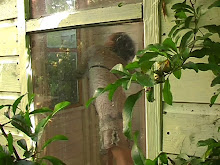LANE
Visual artist Trish O’Shea joined me at Wooda last week, bringing with her fresh ideas and giving new impetus to the project. We both wanted to develop the idea of journeying through landscape so we decided to walk from the studio to the sea at Crackington Haven. We chose to walk the same route twice, each on a different day and starting at a different time of day. For each walk we kept to a predetermined agenda – on the first occasion walking for ten minutes and stopping for two minutes to make notes and on the second we walked for five minutes and stopped for two. By keeping to these time frames we felt more strongly linked to time and place, enabling us to be in the present moment more fully. Each time we stopped at a particular place we recorded in notebooks our observations, thoughts and feelings. We wrote descriptions of sounds, colour, texture, light and objects in an attempt to record what in everyday life can often be overlooked. We took a fresh look at what could be found along a Cornish lane in February. We chose this particular route because it is normally driven along; by walking it we felt a sense of reclaiming what has become the domain of the motor vehicle. We paid attention to the manmade structures in this rural environment – the traffic signs, drainage covers, roadside hydrants, markers and telegraph poles and wires. On our return journeys we noted down all the text – notices, signs, names of houses, etc. - we found along the route and took photographs of the structures we passed.

We chose to use what we had gathered to create a new work in the stable studio at Wooda. The glass walls of the studio allow the ever-changing light from outside to impact on the interior, making it feel as if the space breathes with its surroundings. It is almost like the glass is semi–permeable, allowing the interior to feel part of the land and sky and giving a sensation of being inside and outside simultaneously. Inspired by all of this we chose to print the notes we had made onto transparent window film, which we then placed on the glass. We typed up, cut and pasted the text turning it into two parallel strips of poetry that lead the reader around the circumference of the studio. The text became part of the exterior landscape, linking our words, the structure of the studio and the landscape beyond.

We felt drawn to two containers that we found around the farm, the first being an old trunk and the second a metal container that once stood on wheels. We placed the trunk in the centre of the studio, as its dimensions corresponded to the dimensions of the studio. It is weathered and partially eaten by the horse! (It was once used to hold hay, now it contains dead leaves). The initials printed on its side indicate it once belonged to somebody; it resonates with mystery – to whom did it belong and where did it come from? The trunk seems to hold the past and by reclaiming it we have given it a new place and focus in the present.

We placed the metal container outside the studio on the adjoining decked area. To us it reflects the manmade utilitarian aspects of the land we observed on our walks. The container’s interior alludes to nature, its colours being the same as the local slate, and its patterns reminiscent of seabirds and ripples on water. Placed where it is on its end with its inside surfaces facing the studio, the container reflects energy back inside. It is connected to the interior of the studio by a thin line of pieces of grey slate, starting inside on the studio floor and heading out along the decking to the container. This line is the same shape of the route of our walks as it appears on the map.

To further highlight the connection between the structure, ratio and form of the studio, the trunk and the metal container, we created a series of small boxes covered in the images of the manmade objects we came across on our walks. These boxes give reference to the geometric structures placed along this country lane and draw attention to the relationship between these structures and the wild plants that grow round them.




















